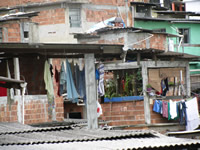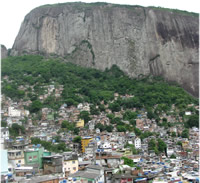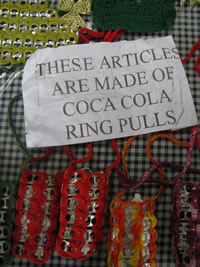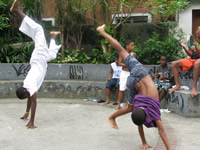 Most tourists only ever see one side of Rio. They will visit the famous sites such as the Christ the Redeemer statue and Pao de Acucar (Sugar Loaf Mountain), Ipanema and Copacabana beaches. But in order to really experience the country there is only one way - visit a favela (slum).
Most tourists only ever see one side of Rio. They will visit the famous sites such as the Christ the Redeemer statue and Pao de Acucar (Sugar Loaf Mountain), Ipanema and Copacabana beaches. But in order to really experience the country there is only one way - visit a favela (slum).Although it might seem strange for tourists to visit the favelas, there have been organized tours into the favelas for many years now. Local tour operator Marcelo Armstrong has been taking tourists into Rocinha and Vila Canoas favelas since 1992 to show visitors to Rio a more realistic view of the city connected to the real life of the local people.
Some may be afraid going into the favela is dangerous and voyeuristic some favelas are all controlled by crime syndicates. But tours into the favela are good for both tour operator and favela residents. Tour operators have to get permission from the favela to take tours through, showing a different side to their city raising awareness. Favela residents get the opportunity to sell to tourists and also come into contact with a different way of life even if only for a moment.
 The favelas lie on the outskirts of Rio crammed up the hillside and nestled against the majestic jungle. As we drive into the Rocinha favela, home to some 85,000 people, rubbish lines the streets and the smell is not pleasant. We stop to take photos but Simone our guide warns us we cannot take photos at certain places in the favela as the crime syndicate does not want their identity unwittingly revealed. Residents have set up tables selling paintings at the van stop. The tour has provided an opportunity for some favela residents to start their own business.
The favelas lie on the outskirts of Rio crammed up the hillside and nestled against the majestic jungle. As we drive into the Rocinha favela, home to some 85,000 people, rubbish lines the streets and the smell is not pleasant. We stop to take photos but Simone our guide warns us we cannot take photos at certain places in the favela as the crime syndicate does not want their identity unwittingly revealed. Residents have set up tables selling paintings at the van stop. The tour has provided an opportunity for some favela residents to start their own business.
Although I know favela can become a place of warfare from time to time if rivaling gangs shoot it out in the street today the favela seems incredibly normal. People go about their daily life, there are a variety of shops, a bank and even a 'Bob's' - a well known Rio fast food chain. But Simone points out that the young men lounging innocently around the favela are members of the gang. Although it might seem like ordinary life they are actually watching closely everybody that comes and goes from the favela.
 Next we drive to Vila Canoas favela. This smaller favela, which houses 2500 residents, is vastly different from Rocinha. No rubbish lies in the streets, residents are well dressed and houses neatly maintained. Simone tells us that this is partly due to the school financed by Marcelo's Favela Tour where 65 students come each day for free to gain an additional four hours of schooling. The benefits have gradually spread into the rest of the community.
Next we drive to Vila Canoas favela. This smaller favela, which houses 2500 residents, is vastly different from Rocinha. No rubbish lies in the streets, residents are well dressed and houses neatly maintained. Simone tells us that this is partly due to the school financed by Marcelo's Favela Tour where 65 students come each day for free to gain an additional four hours of schooling. The benefits have gradually spread into the rest of the community.
We walk through twisting passageways and past favela houses going deeper into the heat of Vila Canoas stopping at the school where students are playing soccer. A handcraft market at the school sells crafts made by locals from recycled waste including bags crocheted with ring pulls from Coca Cola bottles and beautiful paper bowls made from recycled magazines. In the square local children practice capoeira – an Afro-Brazilian art form that combines dance, music and martial arts.
 To truly understand Brazil and its people all tourists should take a tour of the favela because although the favela is usually thought of as being just related to violence and crime it is also a place that many Brazilians call home. As we drive out of the favela I know I have seen a side of Rio many tourists will never see, one of poverty but also one of hope.
To truly understand Brazil and its people all tourists should take a tour of the favela because although the favela is usually thought of as being just related to violence and crime it is also a place that many Brazilians call home. As we drive out of the favela I know I have seen a side of Rio many tourists will never see, one of poverty but also one of hope.